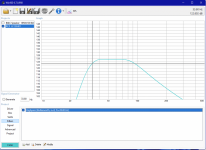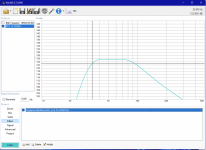Hello everybody,
I wanted to design and build a PA subwoofer. I've already build some speakers and got a tiny bit of experience.
I wanted to build a 6th order sub (no particular reason, there just are a lot of standard vented ones(yes I see the hint) and I just wanted something special).
As design software I used http://speakerboxlite.com or WinISD. (similar results)
But I run into one problem: Whatever I do, whatever driver I choose, i always run into excursion problems. And not insignificant ones.
Here for the RCF LF15G401 we have multiple times xmax.

Is that a Problem? How do I select a chassis for a 6th order? Or is it just dumb to build?
As a target for this project I wanted to build a sub to play -3 from around 33hz (so I'm ok with a loudness penalty for playing deep).
If you read this far, thank you so much for your time already 🙂
I wanted to design and build a PA subwoofer. I've already build some speakers and got a tiny bit of experience.
I wanted to build a 6th order sub (no particular reason, there just are a lot of standard vented ones(yes I see the hint) and I just wanted something special).
As design software I used http://speakerboxlite.com or WinISD. (similar results)
But I run into one problem: Whatever I do, whatever driver I choose, i always run into excursion problems. And not insignificant ones.
Here for the RCF LF15G401 we have multiple times xmax.
Is that a Problem? How do I select a chassis for a 6th order? Or is it just dumb to build?
As a target for this project I wanted to build a sub to play -3 from around 33hz (so I'm ok with a loudness penalty for playing deep).
If you read this far, thank you so much for your time already 🙂
ok... then either the driver is not at all suitable to a bandpass design or you just trying to get too much lowend from it. WinISD will generate an default tuning when first run, are you editing that to widen the bandwidth significantly?
I'll rerun it with winisd.
How do I know if its a good woofer for 6th order bandpass? Only thing i've heard is, if its good for a vented, its good for a 6th order. If its good for closed its good for 4th order
How do I know if its a good woofer for 6th order bandpass? Only thing i've heard is, if its good for a vented, its good for a 6th order. If its good for closed its good for 4th order
I just tried a couple sims in WinISD with that driver, 6th order with 25hz and 95hz chamber tunings produces a nice bandpass response but the -3dB point is 47hz and it hits xmax right at 800w producing about 124dB. A reflex alignment with the same driver will take 1000w before hitting xmax and gets 3dB louder so probably safe to say a bandpass isn't ideal for this driver.
I've tried it with RCF LF15X401 now. This looks good right? Excursion is well over xmax on 1500W but well below xlim. What do you think?

Yeah that looks good, how far over xmax is it and how does that compare to the excusrion of the reflex sim?
Pretty close actually.
Green is reflex, blue is 6th.
xlim (max before damage) is 50 mm, xmax is 12 mm
Is there a way to find a good 6th order driver or is it trial and error?

Green is reflex, blue is 6th.
xlim (max before damage) is 50 mm, xmax is 12 mm
Is there a way to find a good 6th order driver or is it trial and error?
With vented boxes and PA power levels you really need to use (and model with) a high pass filter to cut excursion below tuning.
That might give your sims better results. (use the filters tab in winISD to add a highpass around 28Hz on the above sim)
Rob.
That might give your sims better results. (use the filters tab in winISD to add a highpass around 28Hz on the above sim)
Rob.
Indeed! Better still is to tune it higher as the BP sim shows, so the pioneers went with a Vb = Vas/1.44, Fb = 1.56x Fs = ~104.16 L/56.16 Hz Fb/Av = Sd vent x 44.4 cm handles full 1600 W/Xmax/Fb, so if wanting a solid 40 Hz, then a ~ 26 Hz Fs is required.
Build it as a box within a box since the vent has to be so large.
Build it as a box within a box since the vent has to be so large.
@SpeakerBob Thanks 🙂
@GM Thanks for those calculations. Are those general guidelines or rules I should better follow to get a good result? Like I've said, I'm not a pro speaker builder and just fiddeling around with the graphs until it matches for me.
I'm not quite sure what Av and "Fb/Av = Sd vent x 44.4 cm" means.
What are the calculations for the other chamber?
Plus, I cant really find a suitable driver thats not 21" that fits into the "1.56x Fs" range.
So with all those informations (and not wanting to build a 21" 😀) I guess the best one is the RCF LF15X401


@GM Thanks for those calculations. Are those general guidelines or rules I should better follow to get a good result? Like I've said, I'm not a pro speaker builder and just fiddeling around with the graphs until it matches for me.
I'm not quite sure what Av and "Fb/Av = Sd vent x 44.4 cm" means.
What are the calculations for the other chamber?
Plus, I cant really find a suitable driver thats not 21" that fits into the "1.56x Fs" range.
So with all those informations (and not wanting to build a 21" 😀) I guess the best one is the RCF LF15X401
Attachments
You're welcome!@GM Thanks for those calculations. Are those general guidelines or rules I should better follow to get a good result? Like I've said, I'm not a pro speaker builder and just fiddeling around with the graphs until it matches for me.
I'm not quite sure what Av and "Fb/Av = Sd vent x 44.4 cm" means.
What are the calculations for the other chamber?
Plus, I cant really find a suitable driver thats not 21" that fits into the "1.56x Fs" range.
So with all those informations (and not wanting to build a 21" 😀) I guess the best one is the RCF LF15X401
A guideline from decades before T/S when drivers had very little linear (low distortion) piston travel (Xmax), though obviously based on well known physics from at least the early 20th century that gave us 'talkie' movies, amplified speaker systems for outdoor huge gatherings 😉 so generally will provide superior performance to a typical T/S alignment.
Vent area (Av), box resonance (Fb), driver effective piston area (Sd), so we want a vent duct/pipe with an area = to the driver's effective area and 44.4 cm long.
As for the RCF, from the excursion plot it ideally needs a somewhat higher high-pass or at least a DSP'd notch to get it down to ~the red line.
It also seems worth mentioning that bandpass boxes can make it difficult to hear a driver distorting. In a high power application, the smell of something overheating may be the first or only sign that something is wrong. With the right tuning, driver/amp choices, and crossovers they can be fine, but if you have a tendency to push things too hard, there can be issues.
Thanks again for the responses and you time @GM and @mattstat
The excursion is below half of Xlim on peak performance. Is that really bad or just a worse sound when it 'clipps over xmax'?
Maybe I got that wrong, but if i have a fixed vent area and lenght give us a fixed vent resonance?Vent area (Av), box resonance (Fb), driver effective piston area (Sd), so we want a vent duct/pipe with an area = to the driver's effective area and 44.4 cm long.
The excursion is below half of Xlim on peak performance. Is that really bad or just a worse sound when it 'clipps over xmax'?
Yes.Maybe I got that wrong, but if i have a fixed vent area and lenght give us a fixed vent resonance?
That said, the system resonance (Fb) is not the same as the "vent resonance".
This article goes into detail:
http://www.eminencedesigner.com/EDTopic14.html
You can think of Xlim of Xmech as "mechanical clipping", a hard limit that can't be exceeded without driver damage, which will result in distinctly non-musical sound, hard clanks, flapping noises, etc.The excursion is below half of Xlim on peak performance. Is that really bad or just a worse sound when it 'clipps over xmax'?
Above Xmax, both the motor (Bl) and suspension linearity fall off rapidly, so distortion may go from 10% to greater than 100% at an exponential rate.
- Home
- Loudspeakers
- Subwoofers
- 6th order PA & excursion

